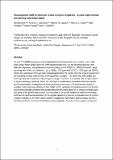Files in this item
Paramagnetic NMR of phenolic oxime copper complexes : a joint experimental and density functional study
Item metadata
| dc.contributor.author | Buehl, Michael | |
| dc.contributor.author | Ashbrook, Sharon Elizabeth | |
| dc.contributor.author | Dawson, Daniel McLean | |
| dc.contributor.author | Doyle, Rachel | |
| dc.contributor.author | Hrobarik, Peter | |
| dc.contributor.author | Kaupp, Martin | |
| dc.contributor.author | Smellie, Iain Archie | |
| dc.date.accessioned | 2017-09-06T23:32:19Z | |
| dc.date.available | 2017-09-06T23:32:19Z | |
| dc.date.issued | 2016-10-07 | |
| dc.identifier | 244334730 | |
| dc.identifier | fb741210-b87c-408a-a467-f11c55b54b20 | |
| dc.identifier | 84985990120 | |
| dc.identifier | 000384807600014 | |
| dc.identifier.citation | Buehl , M , Ashbrook , S E , Dawson , D M , Doyle , R , Hrobarik , P , Kaupp , M & Smellie , I A 2016 , ' Paramagnetic NMR of phenolic oxime copper complexes : a joint experimental and density functional study ' , Chemistry - A European Journal , vol. 22 , no. 43 , pp. 15328-15339 . https://doi.org/10.1002/chem.201602567 | en |
| dc.identifier.issn | 0947-6539 | |
| dc.identifier.other | ORCID: /0000-0002-1095-7143/work/48131822 | |
| dc.identifier.other | ORCID: /0000-0002-4538-6782/work/56638976 | |
| dc.identifier.other | ORCID: /0000-0002-8110-4535/work/34029112 | |
| dc.identifier.other | ORCID: /0000-0002-5829-6487/work/34028572 | |
| dc.identifier.uri | https://hdl.handle.net/10023/11616 | |
| dc.description | This work was supported by EaStCHEM and the School of Chemistry. The authors would like to thank the EPSRC for computational support through the Collaborative Computational Project on NMR Crystallography (CCP-NC), via EP/M022501/1 and EP/J501542/1. SEA would like to thank the Royal Society and Wolfson Foundation for a merit award. Work at the TU Berlin has been carried out within the EU Marie-Curie Initial Training Network “pNMR”. | en |
| dc.description.abstract | 1H and 13C pNMR properties of bis(salicylaldoximato)copper(II) were studied in the solid state using magic-angle-spinning NMR spectroscopy and, for the isolated complex and selected oligomers, using density-functional theory at the PBE0-1/3 // PBE0-D3 level. Large paramagnetic shifts are observed, up to δ(1H) = 272 ppm and δ(13C) = 1006 ppm (at 298 K), which are rationalised through spin delocalisation from the metal onto the organic ligand and the resulting contact shifts arising from hyperfine coupling. The observed shift ranges are best reproduced computationally using exchange-correlation functionals with a high fraction of exact exchange (such as PBE0-1/3). Through a combination of experimental techniques and first-principles computation, a near-complete assignment of the observed signals is possible. Intermolecular effects on the pNMR shifts, modelled computationally in the dimers and trimers through effective decoupling between the local spins via A-tensor and total spin rescaling in the pNMR expression, are indicated to be small. Addition of electron-donating substituents and benzannelation of the organic ligand is predicted computationally to induce notable changes in the NMR signal pattern, suggesting that pNMR spectroscopy can be a sensitive probe for the spin distribution in paramagnetic phenolic oxime copper complexes. | |
| dc.format.extent | 11 | |
| dc.format.extent | 1048333 | |
| dc.language.iso | eng | |
| dc.relation.ispartof | Chemistry - A European Journal | en |
| dc.subject | Chelates | en |
| dc.subject | Density functional calculations | en |
| dc.subject | Materials science | en |
| dc.subject | NMR spectroscopy | en |
| dc.subject | Quantum chemistry | en |
| dc.subject | QD Chemistry | en |
| dc.subject | DAS | en |
| dc.subject | BDC | en |
| dc.subject.lcc | QD | en |
| dc.title | Paramagnetic NMR of phenolic oxime copper complexes : a joint experimental and density functional study | en |
| dc.type | Journal article | en |
| dc.contributor.sponsor | The Royal Society | en |
| dc.contributor.sponsor | EPSRC | en |
| dc.contributor.sponsor | EPSRC | en |
| dc.contributor.sponsor | EPSRC | en |
| dc.contributor.institution | University of St Andrews. School of Chemistry | en |
| dc.contributor.institution | University of St Andrews. EaSTCHEM | en |
| dc.identifier.doi | 10.1002/chem.201602567 | |
| dc.description.status | Peer reviewed | en |
| dc.date.embargoedUntil | 2017-09-06 | |
| dc.identifier.grantnumber | WM150021 | en |
| dc.identifier.grantnumber | EP/M022501/1 | en |
| dc.identifier.grantnumber | EP/J501542/1 | en |
| dc.identifier.grantnumber | EP/J501542/1 | en |
This item appears in the following Collection(s)
Items in the St Andrews Research Repository are protected by copyright, with all rights reserved, unless otherwise indicated.

